RHETORIC AND THE POWER OF WORDS

ONLINE MEETINGS SPUR TRADITION IN THE PHILIPPINES
THEODORE PARVIN
LEGENDARY GRAND RECORDER

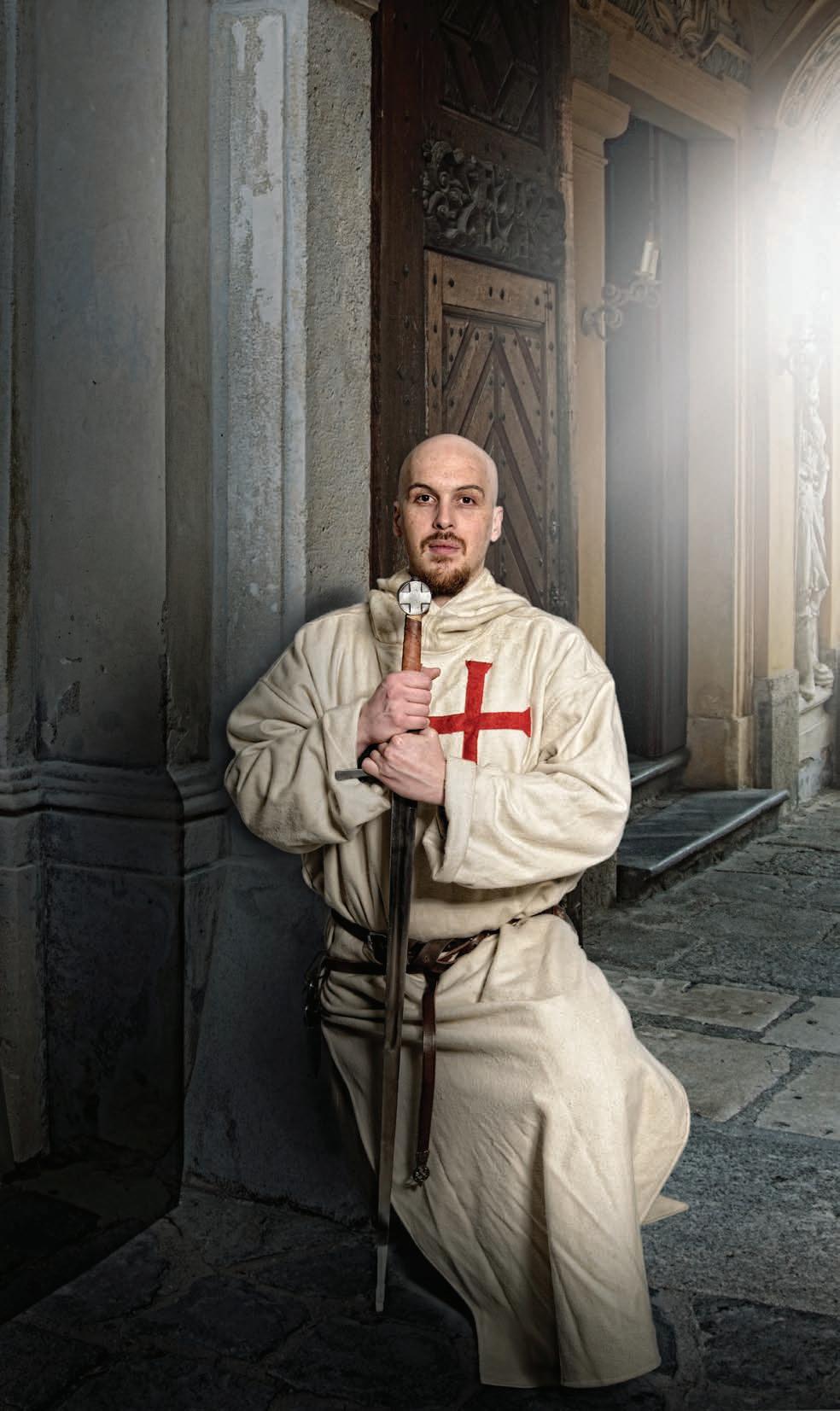
IN HOC SIGNO VINCES JUNE 2023 VOLUME LXIX NUMBER 6
KNIGHT TEMPLAR KNIGHT TEMPLAR

ADDRESS CHANGES AND CHANGES IN MEMBERSHIP
Please report all changes in membership to the Grand Recorder:
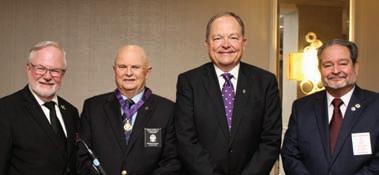
Lawrence E. Tucker
Grand Recorder
Grand Encampment Office
3 Sugar Creek Center Blvd Ste 410
Sugar Land, TX 77478
Phone: (713) 349-8700
Fax: (713) 349-8710
E-mail: larry@gektusa.org
Magazine materials and correspondence to the editor should be sent in electronic form to the managing editor whose contact information is shown below. All photos are licensed or property of the author unless otherwise noted.
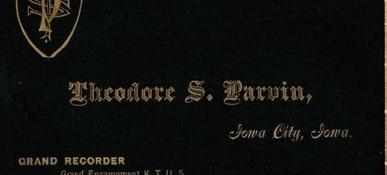 Ben Williams Managing Editor
Ben Williams Managing Editor
1100 W Littleton Blvd Ste 440
Littleton, CO 80120
Phone: (720) 328-5343
Fax: (720) 328-5297
E-mail: ben@knightstemplar.org

knightstemplar.org

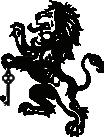
© 2023 Grand Encampment
Knights Templar

Grand Master's Message .............................. 4 Prelate’s Apartment...................................... 6 Theo Parvin ................................................. 7 Rhetoric and the Power of Words ............... 10 Happy Easter ............................................. 16 Masonic News: SGCs Honored as KGTs..... 23 ZOOM Meetings Inspire Tradition .......... 24 Social Order of the Beauceant ................... 26 Knights Templar Eye Foundation Sword of Merit ............................................... 28 Grand Master’s Clubs....................................... 30 VOLUME LXIX JUNE 2023 NUMBER 6
Grand Encampment of Knights Templar of the United States of America
David J. Kussman
Grand Master
David Studley
Grand Captain General and Publisher
Published for the Grand Encampment of Knights Templar of the United States of America by Laughing Lion. KNIGHT TEMPLAR CONTENTS ®
Grand Master’s Message
Sir Knight David J. Kussman, GCT Grand Master of the Grand Encampment of Knights Templar

Our ritual within the bounds of the Orders of Knighthood expresses the importance of freedom and patriotism. The symbol we use to illustrate these virtues is the Flag of the United States of America.
The national observance of Flag Day each June 14 is due to the efforts of Sir Knight William T. Kerr. For more than a half-century, Sir Knight Kerr campaigned for the establishment of Flag Day, appealing to every United States President from William McKinley to Harry S. Truman. He led rallies and continually promoted the idea of a special day to honor “Old Glory.” Kerr was a member of Tancred Commandery No. 48 of Pittsburgh, Pennsylvania.
William T. Kerr was born in Pittsburgh, on September 15, 1868. He attended the public schools there and it is interesting to note that at the early age of fourteen he was concerned with civic, religious, and patriotic issues of the times. He was asked if he would go to Chicago to deliver a Fourth of July speech, and he readily accepted. Newspapers of the day reported upon his interesting and inspiring speech. It was while returning on the train from this trip that he told the chairman of the committee that if we celebrate
our independence on July 4, we ought to have a day to honor our flag. He went on to say that June 14 should be the day since it was the date that the Stars and Stripes became our national emblem in 1777. Thus began the dream, and William Kerr would spend the rest of his life making it a reality.
In 1898, the Western Pennsylvania Flag Day Association was merged into the American Flag Day Association, making it a National Association. Members began sending thousands of letters and telegrams to governors, senators, representatives, civic and religious groups, radio, newspapers, and magazines all encouraging the President to make Flag Day a National Holiday. The Sun Telegraph of Pittsburgh began calling Kerr the “Father of Flag Day.”
The American Flag Day Association, never tiring in their mission were finally blessed to learn that the eighty-first Congress finally passed a bill making June 14 the official day to honor this country’s emblem. That law states:
Resolved by the Senate and the House of Representatives of the United States of America in Congress assembled.
4 june 2023
That the 14th day of June of each year is hereby designated as “Flag Day,” and the President of the United States is authorized and requested to issue annually a proclamation calling upon officials of the Government buildings, on such day, and urging people to observe the day as the anniversary of the adoption, on June fourteenth, 1777, by the Continental Congress of the Stars and Stripes as the official flag of the United States of America.

Thus, after more than fifty years of continuing effort, S.K. William T. Kerr was able to see his dream come true. In the late summer of 1949, William Kerr was asked to witness the signing into law of this Congressional Bill. He was eighty years old and in failing health when he went to Washington DC to watch President Harry S. Truman sign the Flag Day Act on August 3.

SK William T. Kerr died four years
later in 1953. At the town library in Yeadon, Pennsylvania, there is a plaque honoring William T. Kerr, the man who spent his life making his boyhood dream come true. May we never forget…
David J. Kussman, GCT Grand Master
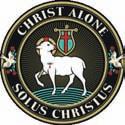
5 knight templar
Veritas • Perspicuitas • Templarii
After more than fifty years of continuing effort, S.K. William T. Kerr was able to see his dream come true.
Prelate’s Apartment
Rev. Terry L. Plemons
Grand Prelate of the Grand Encampment
⁶If we say that we have fellowship with Him and yet walk in the darkness, we lie and do not practice the truth; ⁷but if we walk in the Light as He Himself is in the Light, we have fellowship with one another, and the blood of Jesus His Son cleanses us from all sin.
1 John 1:6-7 NASB
FELLOWSHIP
Hebrews 10:24-25 teaches us the importance of gathering together. So, when we think about everyone we interact with, and that that repeated interaction becomes a relationship, suddenly we realize, as we continually see one another, we are in fellowship.
The word fellowship comes from the Greek word koinonia, and it is that fellowship that is so important to us. Fellowship is our gathering around a common bond starting with Templary, but grows into so much more. Templary may be the anchor, but it is Christian Knighthood that keeps us locked together.
As we share life experiences, common goals and genuine fellowship, Koinonia begins to happen. Suddenly we recognize we’re working together for a common purpose, and we’re enjoying it because we’re together. Friendship and fellowship go hand in hand.
I’ve made so many friends as I travel to various masonic events, that I keep going back because I look forward to being in
fellowship with them – with you – once again.
Dose it get expensive? Yes, sometimes it does, I would have to admit that, but being together with you in fellowship is worth every penny to me.
For me, fellowship isn’t what happens at a stated meeting, while we listen to the secretary drone on reading the minutes or watch sideliners sleep wondering what they’re dreaming about. Don’t get me wrong, stated meetings are important – it’s where work gets done. But the time before, or after that stated meeting, while sharing a meal or just talking about our life experiences is where we truly get to know one another.
1Therefore if there is any encouragement in Christ, if any consolation of love, if any fellowship of the Spirit, if any affection and compassion, 2make my joy complete by being of the same mind, maintaining the same love, united in spirit, intent on one purpose.
– Philippians 2:1-2 NASB
See you at the next gathering,
Paul Erickson Grand Prelate
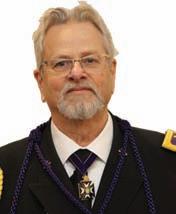
6 june 2023
–
Theodore S. Parvin
Legendary Templar Grand Recorder and his two Special Card Catalogs
 by James A. Marples
by James A. Marples
Theodore Sutton Parvin was a legendary Templar Grand Recorder with immense friends. He was born January 15, 1817, in New Jersey and died at his Iowa home in 1901. He studied law, served three terms as a probate judge, and was involved in numerous other civic posts. Parvin was one of the founders of the Grand Lodge for the State of Iowa. Additionally, he served for many years – not only as Grand Recorder of Iowa's Grand Commandery – but also as Grand Recorder of the Grand Encampment.
Further, he was coroneted a Sovereign Grand Inspector General, Active 33º, for the Ancient and Accepted Scottish Rite Southern Jurisdiction of the USA.

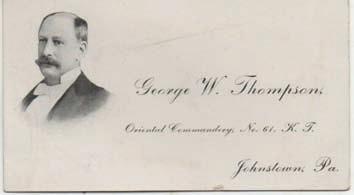

Perhaps Sir Knight Parvin's great love was books – many, many books. Out of his own collection, he instigated and initiated the library of the Grand Lodge of Iowa. Ultimately it grew into one of the most extensive Masonic libraries in the world.
Theodore Parvin was a big believer in the Dewey Decimal System, which allows books to be indexed according to subject, as opposed to being stored on a shelf by date of acquisition. Although somewhat obsolete now, the Dewey Decimal System had the following major categories:
000-099 General Information
100-199 Philosophy & Psychology
200-299 Religion
300-399 Social Sciences
400-499 Language
500-599 Science
600-699 Technology
7 knight templar
700-799 Arts & Recreation
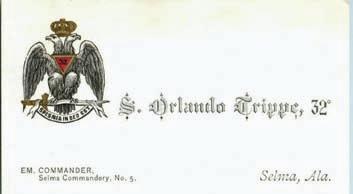





800-899 Literature
900-999 History & Geography
Today's modern book classifications may differ according to Fiction versus Non-Fiction, Biographies, Music, etc., but the same distinctions still pretty much prevail. In addition to his Dewey Decimal card-catalog, Sir Knight Theo Parvin had a sizable collection of Masonic business cards. He, himself, had his own fraternal card and he encouraged other Masons of the various Degrees to personalize their name, their mark, or their unique design on a card. Parvin had sort of a clip-mounted Rolodex system upon which he could easily sort through the cards. Here is just a small sampling of his collection.

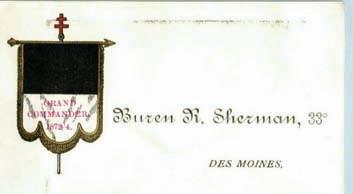
8 june 2023
In this Sign
by Garron C. Daniels
I look to the sun, Before a battle yet won. I look for some sort of sign, To see if the victory will be mine.
Who do I look to in my hour of need? Who will be the one to help me lead; To help me sit upon the Emperor’s throne? Or maybe in this life I am all but alone?
Wait, look! Look! A cross appears! I fall to my knees with tears; For it has a message I dare not dismiss. For the heavens tell me to, “Conquer by this”!
Who is this who gave me aid? Could it be the one who at Golgotha had paid? The one whose blood was spilt for me? The one who broke the bonds of sin and set all free?
Why yes, I do believe that it was him; The one who came when all was grim. For now all is finally clear within my sight, Because I see Christ, his mercy and his light.
This poem is written in devotion and inspiration to Saint Constantine the Great. I write this after some time in prayer and in my writing of my latest book, Devotion to St. Constantine the Great: Emperor, Convert, and Devout Follower of Christ. I believe we have a lot to learn from Constantine, both as Knight and as Christians. The book and more info about Saint Constantine can be found on www.perfectashlarpublishing.com/books.
9 knight templar
POETRY
RHETORIC
As Fellow Craft Masons, we all ascend a winding flight of stairs which represents “a grand philosophical legend, whose rugged steps are symbols of stages of instruction; and our laborious assent symbolizes our struggles to reach the summit of knowledge, where alone the craftsman can receive his reward, the Divine Word, the Truth” (Louisiana Masonic Monitor, p. 88). And one of the last seven steps on that staircase implies that we ought to be welleducated in the discipline of Rhetoric: “the art of speaking eloquently.”
The two most important themes in Freemasonry are the allegorical endeavor to build the Temple and the symbolic search for the lost Word. Thus, it should be no surprise that the art of rhetoric, which is the art of using and understanding words effectively, is an important skill for Masons to acquire.


Masonry is an initiatic system of morality which uses allegories and symbols as its methods of philosophical instruction. Symbols are signs, whether visible, audible, or palpable, which represent ideas. For example, the working tools are visible signs

RHETORIC
used by operative Masons to represent moral principles and philosophical ideas. The pass grips and true grips are palpable signs. Even in the darkness, a Masonic grip doesn’t lose its brotherly meaning. And words are audible signs when spoken, visual when written. All languages are symbolic, and all words are symbols. Whether written or spoken, words are composite symbols composed of individual symbols; audible sounds and visible letters or glyphs accepted to represent things and ideas. In the English language as well as many others, spoken words are
compositions of various vowel and consonant sounds. Written words are composed of letters that symbolize those sounds. Some of the words we use are symbols so old that we don’t remember where they came from. We use them and think of them as if they’ve existed forever. But they don’t come from nowhere, of course. All words can be etymologically traced back to some original sound or root word that inspired them. For example, the words “munch,” “crunch,” “chomp,” and “zip” are all words named after the sounds they imply. The words “munch,”



“crunch,” and “chomp” phonetically imitate the sounds made when one is eating and the word “zip” imitates the sound one hears when zipping up a zipper. Words such as these, which phonetically imitate, approximate, or resemble the sounds they describe, are known as onomatopoeic words.
Not all words are onomatopoeic, however. In fact, most are not. Most of the time, a word is just an arbitrary sound created by people who have attached a meaning to it. Words are merely social conventions, concepts created by human beings as a means of relaying thoughts and ideas to others by way of spoken and written language. Words and sounds don’t have inherent meanings. That is, they don’t just naturally have meaning. They only have meaning when we, whether as individual people or entire cultures or societies of people, give them meaning. For example, a word like “water” only denotes a natural, wet substance because somebody decided that it should, somebody else went along with it, many other people eventually followed suit, and so it became a commonplace term for that substance. But any other sound would have been just as suitable. The English word for “water” isn’t any more or less suitable than the Italian “aqua” or the French “eau, ” both of which denote the same substance in their respective languages. The etymology of the English word “water” can be traced back to the Proto-Indo-European word “wódr,” from the root “wed,” meaning “wet.”
Over a long period of time the Proto-Indo-European “wódr” became the Proto-Germanic “watōr,” the Proto-West Germanic “watar,” the Old
English “wæter,” and eventually the Middle English “water” which we’re familiar with today.


The English word “God” is like that, also. It descended from a myriad of older variations, including the German “Gott,” Proto-Germanic “Guthan,” old Norse “Ghuo,” the Proto-Indo-European “Ghut,” etc. The English word “God” is just one of many names that we human beings have created and used as a means of referring to the Supreme Being. Also, it’s not commonly known as the specific name of any particular deity, but rather as a generic term for deity in general.
In Shakespeare’s Romeo and Juliet, a beautiful soliloquy is given by Juliet regarding the inherent meaninglessness of names. “What’s in a name? That which we call a rose by any other name would smell just as sweet.” So it is with God. Though the names used by various cultures in reference to the Supreme Being change over time, the supreme essence of that Being remains unchanged. If there is but one God, and He is the only eternal, self-existent Being without beginning or end, who gave Him a name? Names are given to God by people. We invent concepts and names for God, but whatever God is remains unaffected by those names and concepts. If the Supreme Being is limitless and infinite, as we in the Judeo-Christian tradition believe, then His nature is beyond our finite comprehension. We human beings are finite creatures living in a finite universe. Our five senses, with
12 june 2023
which we experience the world, are limited. Everything we experience with those senses is likewise limited. There’s nothing in our world of experience that can’t be measured, quantified, or qualified in some way. The limitations or physical boundaries of an object are what make it a distinguishable object.
Anything that has a form is subject to limitation because forms are limitations in and of themselves. If God is infinite and limitless, then He transcends all forms, names, and concepts, which are finite limitations.

Thus, all the names we apply to God are but effable substitutes for an ineffable nature that is mysterious to the point of being unutterable. Limitation is all we know. Limitation is all that is effable. To name is to quantify, a name is to limit.

13 knight templar
The finite mind of man, which knows only limitation, cannot comprehend the infinite, limitless nature of God. That being the case, it’s impossible for anyone to have a monopoly on God. If He is all that is, was, and will be – and even that which won’t be –then He composes all three modes of being simultaneously and thus constitutes the whole totality of reality. That means that God, the Supreme Being, is the very precondition of being. The word “being” is a verb rather than a noun – an action rather than an object – a how rather than a what.

The term Supreme Being therefore alludes to the idea that God is not so much what reality is, but rather how reality is. Infinite, limitless, omniscient, omnipotent, and omnipresent isness is that which the Supreme Being is.
Perhaps, therefore, the only thing that can be accurately said of God, in words that don’t fall infinitely short by default, is simply to say that the Supreme Being is.
“The Mason should be humble and modest toward the Grand Architect of the Universe, and not impugn His Wisdom, nor set up his own imperfect sense of Right against His providence and dispensations, nor attempt too rashly to explore the Mysteries of God‘s Infinite Essence and inscrutable plans, and of that Great Nature which we are not made capable to understand” (Morals & Dogma, Annotated Ed., p. 412).
Is it any wonder, then, that Freemasonry asks only if you believe in the existence of one Supreme Being? That precise rhetoric is deliberate, and the specific reason for it is the foundational philosophy of Freemasonry.
There is only one eternal God; and therefore all men are brothers under the Fatherhood of the same Supreme Being, though we all have our own respective names and concepts for Him.
Masonry’s deliberate use of rhetoric teaches the philosophy of the Universal
Fatherhood of God and the Brotherhood of Man. When we spread the idea that God
— who is Love — is the universal Father of all mankind, we plant charitable seeds in the hearts of our fellow men and facilitate a spirit of brotherly love between all who hear, understand, and act in accordance with that idea.
By the exercise of Brotherly Love we regard the whole human species as one family. The high and low, the rich and the poor who, created by one Almighty Parent and made inhabitants of the same planet, are to aid and protect one another. On this principle Masonry unites men of every country, sect and opinion, and conciliates true friendship among those who might otherwise have remained forever apart.
Pay close attention to the lectures of Freemasonry and you’ll see that in every degree, from the first to the last, Masonic rhetoric is intended to persuade you to consider the eternal, infinite, ineffable nature of God, the immortality of the soul, and the kinship or brotherhood of Humanity.
The way we use rhetoric is important, not just to us as Masons but to everyone, because it is how we take general ideas and make them more specific and persuasive. Rhetoric is an artform that uses specific language as a deliberate means of evoking a desired response from a reader or audience, and it does so by three modes of persuasion: ethos, pathos, and logos.
Ethos is a rhetorical technique, or mode of persuasion, in which the author (or speaker) tries to gain the trust of his audience by demonstrating himself to be knowledgeable, relatable, credentialed, or otherwise trustworthy. If an attorney is speaking to a jury in the defense of his client and he
Continued on page 18
Standard License Adobe
Louisiana Masonic Monitor, p. 66


HAPPY EASTER


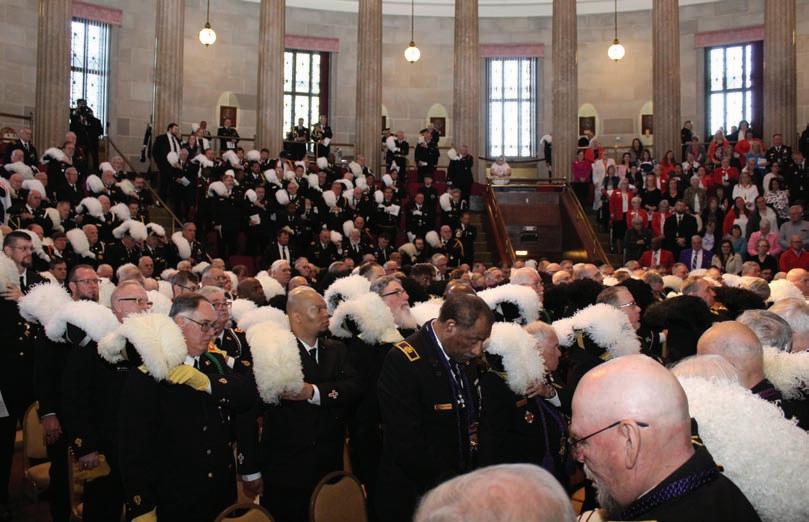
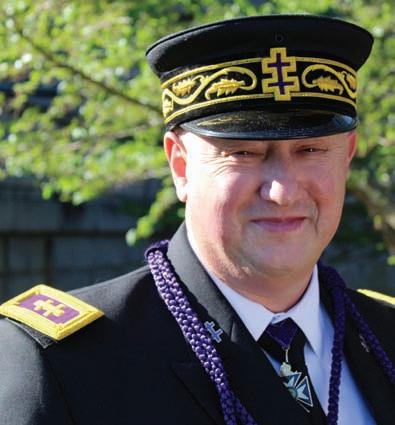
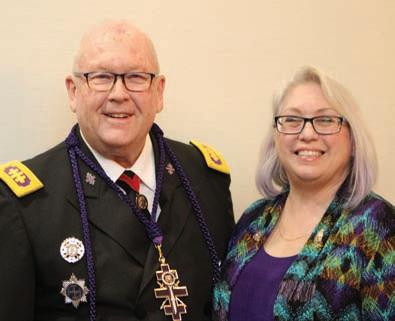
1.
2.
3.
4.
5.
two PGMs,


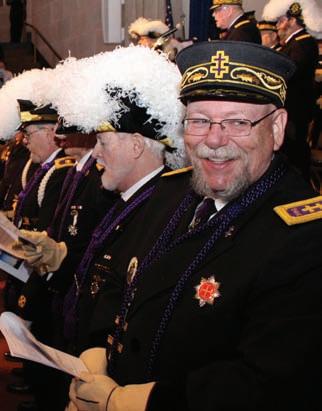
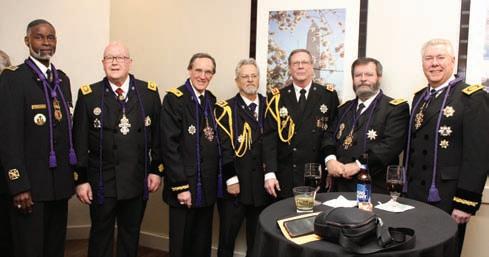
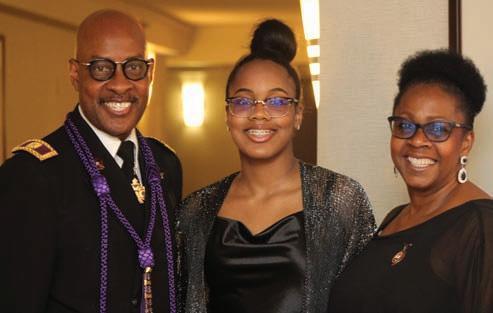
6. 7.
9.
10.
8.
1. The congregation prepares for prayer. 2. The congregation at song. 3 Happy Easter from the Grand Master and Lady Kim. 4. S.K. Treklas shows off his black feathers, courtesy of the Grand Commandery of Maryland.
5. S.K. Loughlan waiting for the bus. 6. A Past Grand Commander and his family. 7. Gerry Pugh, PDC. 8. Distinguished guests: a PGC, the GM,
two Grand Prelates, and one KTEF Manager. 9. S.K. Terry Plemons preaches the word. 10. GM Kussman opens the ceremony.
Photos by Ben Williams
mentions that he went to Harvard Law School, it is because he wants the people in the jury to be impressed by his education and therefore be more inclined to believe him to be authoritative. That is an example of appealing to the ethos of your audience.
Pathos is a rhetorical technique, or mode of persuasion, in which the author appeals to his audience’s emotions. If a trial lawyer tells a sad story about his client in hopes that the jurors might take pity and/or the judge may issue a lighter sentence, he is using the rhetorical device of pathos.


Logos is a rhetorical technique, or mode of persuasion, in which the author appeals to the logic of his audience. Anytime someone uses facts, statistics, metaphors, and analogies to connect ideas in a clear, coherent way and thereby win an argument, they are using the rhetorical device of logos.
Using any of the above-mentioned rhetorical devices skillfully will make a person more effective at communication. Yet one who makes masterful use of all three of these devices is a formidable force in the world. After all, as the English author, Edward Bulwer-Lytton, famously said, “the pen is mightier than the sword.”
The rhetoric we use, whether unwittingly or deliberately, affects the world around us. We should be cautious with our choice of words. Thus, the Tyler’s Sword and Book of Constitutions are explained together in the third section lecture of the Master Mason Degree as symbols alluding to the importance of silence and circumspection. Words convey ideas, and ideas inspire actions. The kind of ideas we spread are of
the utmost importance, for they ultimately affect the kind of world we live in. If you use peaceful words, for example, you’ll find that the people with whom you speak will be at peace. But if you use divisive or inflammatory speech, the people with whom you’re communicating will become tense, agitated, or worse – even violent.
As I’ve already mentioned, Freemasonry uses specific rhetoric in reference to the Supreme Being. As peace and harmony are the chief strength and support of our noble institution, we refer to God by universal terms such as the Great Architect of the Universe so that we may facilitate an atmosphere where there is no religious strife or division between the brethren in the Lodge. We esteem God as “the Chief Good” because the ideas we spread about God affect the way people act towards one another. If people
which you build your Temple.
If your god – the ideal enshrined upon the highest pedestal of your mind – is money, then your character will be marked by greed. But if to you God is Love, then your character will be marked by Grace. You become an incarnation of your most precious ideal. As the Master said, "where your treasure is, there your heart will be also” (Matthew 6:21). The more goodness you attribute to God, the more goodness you’ll attribute to His creation. The more you love God, who is Love, the more you’ll love that which He loves: the World. Humanity. If you say that man is created in God’s image and that God is good, then you’ll be inclined to see something good in mankind. To think and speak of God with the highest praise and utmost reverence is thus exceedingly important. Not only are we made in the image of God, we
conceive of God as a mean, angry, contentious, cruel being, then they will become mean, angry, contentious, and cruel themselves.
Your concept of God sets the tone for your concept of what is good, and your conception of goodness is the very foundation of your character. The loftier and nobler your concept of God, the higher your conception of goodness, the better the foundation of your character will be. If you esteem God as the Chief Good, higher than the highest goodness you’re capable of comprehending, then that conception of Divinity will become the archetypal ideal of your life. It will become your true north, the pole star by which you orient yourself out of the darkness of error towards the light of Truth. It will become the blueprint or trestleboard by
make ourselves in the image of the concept of God we enshrine in our minds.
This is the reason, I believe, why the greatest commandment (according to the Judeo-Christian tradition) is to love God with all your heart, might, mind, soul, and strength, and the second commandment, like unto it, is to love your neighbor as yourself.

If you truly love your neighbor, you’ll always try to see the good in him. You’ll speak well of him so that others will think as highly of him as possible, too. It’s a Masonic offense to speak evil of a brother Master Mason because it’s evil to degrade and defame the character of your fellow man who is likely just as flawed – and certainly as beloved of God – as are you.
He who loves God will praise God in thought, word, and deed, and he who does
"If you truly love your neighbor, you'll always try to see the good in him."
not love his fellow man whom he has seen cannot possibly love God, whom he has not seen. Thus, just like you’ll sing God’s praises if you truly love Him, you’ll also keep a tongue of good report for your brother.
If men weighed the imperfections of humanity, they would breathe less condemnation. Ignorance gives disparagement a louder tongue than knowledge does. Wise men had rather know, than tell. Frequent dispraises are but the faults of uncharitable wit: and it is from where there is no judgment, that the heaviest judgment comes; for self-examination would make all judgments charitable. If we even do know vices in men, we can scarce show ourselves in a nobler virtue than in the charity of concealing them: if that be not a flattery persuading to continuance. And it is the basest office man can fall into, to make his tongue the defamer of the worthy man.
Morals & Dogma
Annotated Ed., pp. 411-412.

Brotherly Love, synonymous with Charity,
“writes the faults of a Brother on the shifting sands and his virtues on tables of enduring marble.”

Louisiana Masonic Monitor, p. 149
In the lecture of the Prussian Knight or Noachite Degree of the Ancient and Accepted Scottish Rite, Southern Jurisdiction, we learn that, “Charity bids us think the best, and leave what we know not to the Searcher of Hearts; for mistakes, suspicions, and envy often injure a clear fame; and there is least danger in a charitable construction” (Morals & Dogma, p. 412). Nobody is perfect. Nobody is one-hundred percent good. Each of us, if we examine ourselves honestly, are characters composed of virtues intermingled with vices. And to quote the twenty-first degree Prussian Knight lecture again, “there is but one rule for the Mason in this matter. If there be virtues, and he is called upon to speak of him who owns them, let him tell them forth impartially. And if there be vices mixed with them, let him be
content that the world shall know them by some other tongue than his” (Morals & Dogma, p. 412).
To put it in even more simplistic, digestible terms, perhaps a quote from the Disney movie, Bambi, sums it sufficiently. When the young rabbit, Thumper, had criticized Bambi as being “kinda wobbly,” his mother scolded him and made him verbally repeat the following rule: “if you can’t say something nice, don’t say nothing at all.”
Thumper’s rule is simple enough for a child to understand, and yet there are many grown people who do not comprehend it. Worse yet, some of those grown men are Masons. We’ve all met Masons who unfortunately don’t understand that simple principle, and we’ve all seen the kind of strife that occurs in a lodge when a Mason speaks with ignorant, derogatory, or otherwise uncharitable rhetoric toward or about another brother.
In the Entered Apprentice degree we learn that “the Lodge is a symbol of the world” (Louisiana Monitor, p. 46). When it has quality leadership and brethren who sincerely love each other, the lodge is a miniature model of the ideal world – an archetypal society that is practically synonymous with the idea which Jesus called the Kingdom of Heaven. But if it has poor leadership and brethren who allow divisive quarrels to occur among them, then the lodge becomes a miniature model of the profane world we all know too well.
It’s truly sad to see Masons who get jealous or covetous of other brethren, especially if they’re merely jealous of their Masonic titles. And it’s downright tragic to see a brother engage in divisive politics so that he might manipulate his way into obtaining a particular office or title.
We’ve all seen some unworthy Masons sink so despicably low as to wage subtle wars of rumor-mill rhetoric against brethren who hold or are soon to be holding Masonic positions they covet, spreading gossip about them
to tarnish their reputation and covertly sabotage their endeavors. It happens at the lodge level as well as at the grand lodge level, but it shouldn’t happen at all in our Fraternity.
There is scarcely anything less Masonic and more profane than to deliberately cause division between people – especially the brethren. Such subversive tactics – deploying divisive rhetoric for the sake of personal gain and egotistical gratification – are the techniques of power-hungry demagogues, would-be tyrants who hope to divide so they may conquer, corrupt politicians who manipulate the people of one persuasion to fear or hate those of another, just so that they might get more votes and acquire a coveted position of influence.
Such evil ambition is an archetypal enemy of mankind, and we Masons must be keenly aware of that. We must diligently search for, capture, and put down that inner ruffian of Evil Ambition – along with the other two ruffians which are Fanaticism and Ignorance – when we find them in ourselves. But we must also be tirelessly, ceaselessly engaged in the endeavor to oppose and thwart all the efforts of the despotic demagogues, charlatans, and barbarians in our respective societies.
There’s an anonymous saying, often misattributed to Edmond Burke, but true in principle nevertheless, which states that “the only thing necessary for the triumph of evil is for good men to do nothing.”
One hundred percent of all wars through the history of the world arise for economic reasons; that is, seeking or countering impetus for power and influence or monetary gain. One can’t fight a war without an army, so the warmonger does whatever he can to enlist the support of as many people as possible. The easiest way to do that is to convince ignorant people to fear those against whom he’s waging war. All wars arise by greed or a lust for power, and propaganda

is the first weapon deployed to set things in motion. Before any swords are drawn, guns are fired, or missiles are launched, divisive rhetoric is first used to stoke up agitation and fear.
Dehumanizing rhetoric is a hallmark of dangerous speech. Whether it is used deliberately by those with evil ambition or those who are simply careless, it affects people’s thoughts and perceptions and makes injustice and violence more acceptable to them. Take, for example, the kind of rhetoric that Hitler and the Nazi party used in reference to the Jews. Anti-Semitic rhetoric was used heavily in Nazi propaganda. Among other derogatory and dehumanizing terms,
had deceived ordinary, German people into believing absurd things about Jews. The slaughter of Native Americans in numerous massacres happened because some politicians used propaganda to convince ordinary people to believe that the Indians were lessthan-human heathens.
Anti-abolitionists used dehumanizing rhetoric toward black people prior to the American Civil War as a means of preserving their status quo and keeping the deplorably evil institution of slavery legal; similar rhetoric was used by anti-integrationists after that war ended and slavery was abolished in the United States. The same kind of prejudiced, divisive rhetoric that anti-abolitionists had

Jewish people were referred to by Hitler and the Nazis as untermenschen, or subhumans. The horrors of the holocaust are irrefutable evidence of the dangerous ways in which divisive, dehumanizing rhetoric can affect the psychology and morality of an entire nation.
It’s important to realize that our words, and especially the words of people in positions of power and influence, can lead to terrifying injustices: even to the extent of genocide.
Dehumanizing rhetoric is the first step towards war and genocide. As our brother Voltaire eloquently said, “anyone who can make you believe absurdities can make you commit atrocities.” Terrorist attacks happen because ignorant people are manipulated by demagogues and charlatans into believing absurd things, and then they act on those beliefs. Similarly, the atrocious crimes against humanity which occurred at Auschwitz and other Nazi concentration camps happened because the dehumanizing rhetoric of Hitler
used in support of slavery was used yet again by those who later legislated the Jim Crow laws and promoted racial segregation. The world is full of people who divide society, but we Masons are called to unite it. The world is full of people who make vast chasms separating classes of citizens, but we Masons are called to construct bridges of brotherly love to connect those who might have otherwise remained at a perpetual distance. The world is full of people who destructively broadcast words of wrath, but we Masons are called to constructively whisper words of wisdom. Whereas the words of tyrants and charlatans are used to manipulate the ignorant and dehumanize groups of people, the rhetoric of a Mason must serve to educate, enlighten, and ennoble all of mankind.
Keep, therefore, a tongue of good report. Study the art of rhetoric and use it well for the glory of God and the good of Humanity.
"Dehumanizing rhetoric . . .affects people’s thoughts and perceptions and makes injustice and violence more acceptable to them."
Sovereign Grand Commanders of the Ancient & Accepted Scottish Rite Are Created Knights Grand

Cross of the Temple
APRIL 14 – On Good Friday, in Arlington, Virginia, at the Grand Encampment’s family dinner preceding the Easter Sunrise Observance, Grand Master David Kussman took the podium to recognize his counterparts in the Ancient and Accepted Scottish Rite, Sir Knight James D. Cole, Sovereign Grand Commander for the Southern Jurisdiction, and Sir Knight Peter J. Samiec, Sovereign Grand Commander for the Northern Jurisdiction, by creating them Knights Grand Cross of the Temple.
Only twenty-four Knights Grand Cross of the Temple are allowed by the Constitution. With more than 65,000 members comprising the Grand Encampment, that means only 0.0004% of our membership are eligible to receive the award.
Since his election to office at the Special Conclave last year, Sir Knight Kussman has taken a unifying and benevolent approach to his office. “We’re all part of one Masonic family,” he said. “The contribution these men have made to Templary crosses the lines between appendant bodies. It is proper to recognize contributions and commitment made to the Craft as a whole. I thank them for their service to the fraternity in general, to the Scottish Rite, but to Templary in particular.”
It’s no secret that the Grand Encampment had been beset by difficulty for some years. But that has already changed. “Now begins the path to healing,” Sir Knight Kussman said. “We must work together for the betterment of our Craft, to build the temple in the hearts of men. One by one, templar by templar, we extend the invisible country. May it come soon, we are needed more than ever!”
NEWS
From Darkness to Light
How meeting online during the pandemic inspired lasting templar observances in the Philippines
by Giovanni A. Villegas
The COVID-19 pandemic of 2020 opened the doors to alternative modes of communication while in quarantine. In the Philippines, like everywhere else around the world, Masonic labors were suspended, and lodges had to resort to online video conferencing platforms such as Zoom in order to maintain contact with their members. Masonic orders such as the Grand Commandery of Knights Templar of the Philippines conducted virtual meetings during the government-imposed lockdowns. Since face-to-face Masonic meetings were temporarily put on hold, their regular businesses also went dark, giving way to online meetings that focused more on well-wishes among brethren, calls for prayers and support, Masonic education webinars, and revival of long-forgotten customs like Masonic toasts. Other revived customs were the Knights Templar observances of Easter, Day of the Ascension, and Christmas.
Commanderies in the Philippines have never really performed these religious services and activities before, at least not for
a very long time. The suspension of official works due to the pandemic provided much needed time and presented an opportunity to start doing so.
On April 12, 2020, Easter Day, Cavite Commandery No. 7 conducted the first online observance of Eastertide. It was perhaps the first ever observance of Easter in the country by Masonic Templary, as the feast day was often commemorated in the past by the Scottish Rite Chapters of Rose Croix during their ceremony of “Relighting of the Lights.” When the pandemic struck, quarantine afforded the Sir Knights of the Philippines opportunity to conduct further learning of their history and traditions. They rediscovered their long-lost heritage, and began commemorating it online.
Then, on May 21, 2020, during the Feast Day of the Ascension of Christ, Cavite Commandery No. 7 again conducted an online observance. T.M. Kalaw Commandery No. 5 likewise led the way in commemorating the Day of the Ascension online among its own members.
24 june 2023
Note, however, that this observance, if virtual, was not the first time the observance was conducted in the Philippines. Back on April 1, 1972, the Grand Commandery of Knights Templar of the Philippines commemorated the Day of the Ascension for the first time in the jurisdiction, – and in full ceremonial form.
Come Christmas season, Commanderies in the Philippines held another observance. On December 18, 2020, Luzon Commandery No. 9 conducted the first online observance of Christmastide in the country. T.M. Commandery No. 5 likewise conducted its own virtual Christmas service soon thereafter.
In the years that followed, these religious observances of Easter, Day of the Ascension, and Christmas are slowly becoming part of the annual traditions of the commanderies in the Philippines. It is hoped that the awareness of these observances continues to become more widespread, reaching all corners of the jurisdiction.

25
knight templar
"When the pandemic struck, quarantine afforded the Sir Knights of the Philippines opportunity to conduct further learning of their history and traditions. They rediscovered their long-lost heritage, and began commemorating it online."
Motto: Love is the Key
Symbols: Heart and Key

Scripture:
John 3: 16
For God so loved the world that He gave His only begotten Son, that whosoever believes in Him shall not perish but have everlasting life.
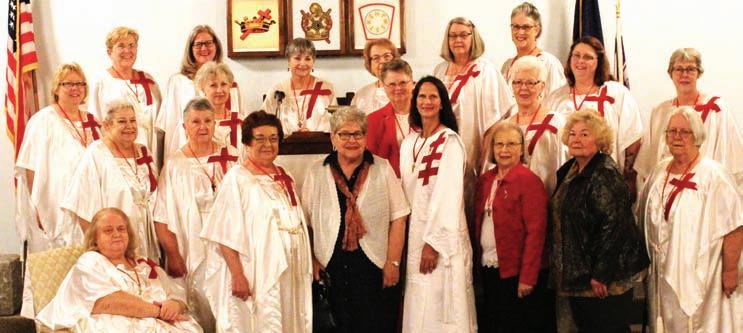
Romans 8: 28
And we know that all things work together for good for those who love God and are called according to His purpose.
Official Visits

26 june 2023
OBITUARY
(Mrs. Jack L.) MaryAnn Edwards Supreme Worthy President (2005-2006)
Official vist at Omaha Assembly No. 91, October 7, 2022, (Mrs. Phil) Doris Edwards, President.



27
knight templar
Official visit at Carnegie Assembly No. 80, December 22, 2022, (Mrs. Charles) Toni Youkin, President.
Official vist at Indianapolis Assembly No. 90, November 16, 2022, Ms. Leah Everet, President.
Joint official vist at Austin Assembly No. 125 and San Antonio Assembly No. 159, February 18, 2023.
Knights Templar Eye Foundation, Inc. of Sword


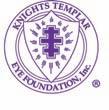
During the banquet of the Annual Grand Conclave of the Grand Commandery of Knights Templar of Tennes see, Sir Knight Terry Plemons, Grand Prelate of the Grand Encampment and Trustee of the Knights Templar Eye Foundation, was pleased to present to Sir Knight Justin M. Huggins, member of Lookout Commandery No. 14, organized in Chattanooga, Tennessee, the Sword of Merit in recognition of his donations to the Grand Masters Club that completed Tier 5: that is twenty-five Grand Master’s Clubs totaling $25,000.
Sir Knight Huggins also received the Golden Chalice Award for donating $10,000 in 2020.

28 june 2023
Merit of
Sir Knight Garland R. Harman, Knights Templar Eye Foundation Chairman for South Carolina, and member of Columbia Commandery No. 2, organized in Columbia, South Carolina, was presented with the Sword of Merit on December 14, 2022, for reaching twenty-five Grand Master Clubs totaling $25,000.
Christopher McDonald, Past Grand Commander. Back row left to right: S.K. Edward E. Smith Jr., Past Commander, Columbia Commandery No. 2; S.K. Brett Van Horn, Generalissimo Columbia Commandery No. 2.
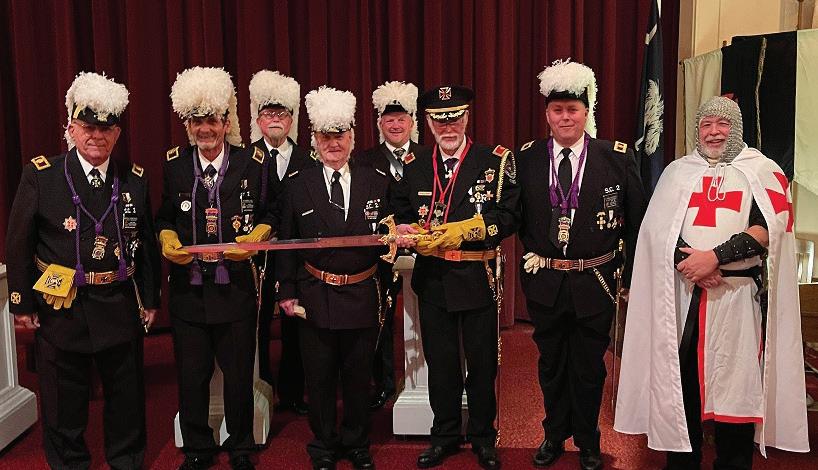
29 knight templar KTEF
Front row left to right: S.K. John R. Marcucci, Past Grand Commander; S.K. Jeffrey L. Hall – Past Grand Commander; S.K. Garland R. "Mike" Harmanrecipient of the Sword of Merit; S.K. Victor Philips, Grand Commander; S.K. Charles Schofield, Past Grand Commander; S.K.
Knights Templar Eye Foundation, Inc.
February 1, 2023 – February 28, 2023
GRAND MASTER’S CLUBS
AL Ronald A. Naumowicz
AL Jerry T. Roberts
AL Amos G. Welborn
AZ John W. Huth
CA John E. Bickerstaff
CO J. L. Johnson
CO Darren Klinefelter
CO Grover L. Sardeson
FL John I. Gray
FL John D. Pickford
FL Damon S. Sansom
GA Timothy P. Kelley
GA Brad P. Simmons
IN Joe F. Gust
MD John H. Austin
MI George M. Otis
MN Clinton J. Christensen
MN Brian K. Dimatteo
NJ Michael Cefaratti III
NJ Neil D. Nagy
NM Randall C. Bond
NC Samuel W. Lipe
OH James T. Cox
OH James G. Fidler
OH Martin R. Trent
OK Robert L. Bradway
SC Ronny D. Powell
TN John R. Allen
TN Andrew N. Bland Sr.
TN Justin M. Huggins
TN James H. Purser
TN Roy T. Sutton III
TX Todd R. Alexander
TX Tommie K. Bushong
TX Jerry M. Wallace
WA Charles R. Davis
WA David L. Hisel
WI Stephen D. Dake
WY Lewis E. Shepherd
GRAND COMMANDER’S CLUBS
AL Michael Kozlik
GA Timothy P. Kelley
MI Alan K. Jacobson
MI James D. Rutherford
MN Brian K. Dimatteo
MO William J. King
NV Montana B. Williams
NM Randall C. Bond
NY Robert L. Lindholm
NC Robert W. Erwin Jr.
OH James G. Fidler
PA Albert H. Eschert
PA Charles E. Lankert
PA Richard L. Pruitt
TN Ralph B. Taylor
TX Todd R. Alexander
TX Jerry M. Wallace
WA Charles R. Davis
WA David L. Hisel
Scientific Advisory Committee Meeting
PEDIATRIC OPHTHALMOLOGY GRANT REVIEW 2023
Annually the Knights Templar Eye Foundation holds a meeting mid-March, this year it was held in Grapevine, Texas with the officers and trustees of the Foundation along with fourteen doctors specializing in pediatric ophthalmology from many leading hospitals and research institutions throughout the country to review the applications and recommend which applications based on the merits of the proposal should be funded up to a $90,000 grant.
For the past two years this annual meeting has been held through ZOOM, this year was a welcome change to be in person and discuss in person
The meeting started at 8:30am CST and concluded at 4:30pm CST – being in person allowed more dialog as our SAC doctors had to review in detail thirty-seven Career Starter Grants and nine Competitive Renewal Grants.
At the end of the review process thirty Competitive Renewal & Career Starter grants for a total of $2,699,449.00 were recommended by the SAC Committee and later approved by the KTEF officers.
Our website https://www.ktef.org/grants has a complete list of the grants that were approved along with the specific research.
Knights Templar Holy Land Pilgrimage for Christian Ministers

2024 – tentatively
Group A: February 5 – February 15, 2024
Group B: February 19 – February 29, 2024
Program Overview, Nomination Forms, Guidelines for Selection, Fees, etc. for local Commanderies and State Committees are available on the website.
In the Footsteps of Jesus
A Pilgrim’s Journey for Sir Knights, Ladies, Friends, and Guests
November 5 – November 15, 2023
For full information, forms, and details, go to: www.kthlp.com
KTEF

Knight Templar 3 Sugar Creek Center Blvd, Ste 410 Sugar Land, TX 77478 NONPROFIT ORG. U.S. POSTAGE PAID Knightstown, IN Permit No. 8





 Ben Williams Managing Editor
Ben Williams Managing Editor










 by James A. Marples
by James A. Marples























































